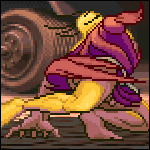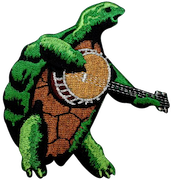|
Totally anecdotal, but I stopped having finger injuries after I started incorporating some fingerboard training into my annual regimen.
|
|
|
|

|
| # ? Apr 20, 2024 03:31 |
|
tortilla_chip posted:Totally anecdotal, but I stopped having finger injuries after I started incorporating some fingerboard training into my annual regimen. This. There's no reason to be afraid of pockets if you train for pockets. That's true for any kind of hold.
|
|
|
|
Cool. Was hoping that having two injuries to the same tendon wouldn't maybe mean I would be prone to them to a degree that would mean not doing them at all. Progressive training should be okay for those types of holds it sounds like.
|
|
|
|
So, I've had this annoying niggling finger issue for over a year - slightly swollen knuckle and first joint (PIP joint) of the middle index finger, slightly reduced range of motion, both of which subside temporarily with stretching but return over time. The one weird thing was that there was a specific spot on the inside of the PIP joint which was quite painful under pressure but otherwise felt totally normal. Amount of pain while climbing is minimal, once properly warmed up. I saw 2 different medical professionals about 4-6 weeks after this originally started (and then another 2 months after that) and both times was told that it was soft tissue damage and that everything would be fine but it might take a long time to heal. Had an x-ray which apparently didn't show any issues. So I've been climbing on it since then, it doesn't really hurt, it just feels slightly hosed up, I figure I just have another minor tendon injury which I need to manage before and after each session (I have a similar-feeling injury on the other hand which I did about 6 months into my climbing career, annoyingly...). I've spent a fair bit of time recently trying to get more range of motion out of the finger with a lot of stretching / massage / exercises and I swear I just incidentally tractioned it into a different position and now it feels basically fine but a bit sore? What even happened here, is it possible that I've been climbing on a partially dislocated finger for a year without knowing? Or could it be some kind of tendon alignment issue that sorted itself out with a bit of pressure in the right place? How the poo poo did an x-ray not pick anything up? I'm pretty sure that something in there actually shifted position in a significant way - apart from the fact that I could physically feel stuff inside the joint moving around, the last 2 bones of the finger are now visibly aligned differently, range of motion is immediately improved, and that one weird painful spot I mentioned earlier has gone from mild stabbing pain under pressure to dull ache. Anyone who knows more about this kind of thing want to try and guess what the gently caress just happened? Either way I feel like I've been subject to some seriously poo poo medical diagnosis 
|
|
|
|
Iíve got a nondisplaced fracture in my ring finger, and as itís been healing, it sounds very very similar to what youíre describing, especially that specific spot being very pressure sensitive. The fracture was so small that it only barely showed up on one X-ray at one angle. They can take a long time to heal. I havenít climbed in three months, and I donít expect to start back any time soon.
|
|
|
|
Bud Manstrong posted:Iíve got a nondisplaced fracture in my ring finger, and as itís been healing, it sounds very very similar to what youíre describing, especially that specific spot being very pressure sensitive. The fracture was so small that it only barely showed up on one X-ray at one angle. They can take a long time to heal. I havenít climbed in three months, and I donít expect to start back any time soon. But I want to climb with you  heal up good buddy...heal up. heal up good buddy...heal up.
|
|
|
|
I've had a minor surgery today but, as a result, I'm out for 2 weeks until the doctor re-examines me and gets the stitches out. What can I do to break in my new climbing shoes without actually climbing?
|
|
|
|
walk around the house in them?
|
|
|
|
I crammed a load of newspaper down the end of my last pair to stretch out the top of the toe box, worked perfectly
|
|
|
|
RabidWeasel posted:I crammed a load of newspaper down the end of my last pair to stretch out the top of the toe box, worked perfectly Thanks, I didn't think of that! Will also start wearing them around the house once I feel a little better. On the subject of shoes, which popular brands work for wider feet? One of the beginner kit options at the store was Scarpa Force V but they were uncomfortably narrow regardless of which size I tried.
|
|
|
|
Supposedly Butora is good for wider feet.
|
|
|
|
Bud Manstrong posted:Supposedly Butora is good for wider feet. They have a wide and narrow shoe, I don't have wide feet so I'm not sure how well it works for that, but the narrow shoe is by far my favorite climbing shoe ever for gym climbing. Aggressive enough to where I never feel like the shoe is the issue but still comfortable enough to wear 30+ minutes or so at a time after breaking it in. Plenty of rubber for toe hooks and the only shoe that I don't hate to wear that doesn't move at all when I have to really dig into a heel hook. Doesn't stretch really at all lengthwise during break-in though so be aware when sizing.
|
|
|
|
From what I've heard Scarpa is supposed to be the wide ones.
|
|
|
|
Syncopated posted:From what I've heard Scarpa is supposed to be the wide ones. There is always the possibility that--as a beginner--I simply have no idea what a fitting climbing shoe is supposed to feel like. In fact, maybe I should've simply tried a size larger than my street shoes. With the Scarpa Force V, downsizing by 0.5 resulted in intense pain even before affixing the velcro strip, while matching my street size was still pretty awful. I ended up going with a pair of downsized Red Chili instead, as I could at least climb the store's demo wall without experiencing extreme discomfort. I still can't wear them for longer than 10 minutes at a time but that's due to the toe box area. As per the thread advice, I stuffed them with newspaper for now.
|
|
|
|
Kryopsis posted:Thanks, I didn't think of that! Will also start wearing them around the house once I feel a little better. La Sportiva Otaki's
|
|
|
|
Kryopsis posted:There is always the possibility that--as a beginner--I simply have no idea what a fitting climbing shoe is supposed to feel like. In fact, maybe I should've simply tried a size larger than my street shoes. With the Scarpa Force V, downsizing by 0.5 resulted in intense pain even before affixing the velcro strip, while matching my street size was still pretty awful. I ended up going with a pair of downsized Red Chili instead, as I could at least climb the store's demo wall without experiencing extreme discomfort. I still can't wear them for longer than 10 minutes at a time but that's due to the toe box area. As per the thread advice, I stuffed them with newspaper for now. Depending on what kind of climbing you want to do, 10 minutes is okay so long as you can actually climb in them. If you're doing big routes in the mountains you might need something else.
|
|
|
|
Kryopsis posted:With the Scarpa Force V, downsizing by 0.5 resulted in intense pain even before affixing the velcro strip, while matching my street size was still pretty awful. I ended up going with a pair of downsized Red Chili instead, as I could at least climb the store's demo wall without experiencing extreme discomfort. I still can't wear them for longer than 10 minutes at a time but that's due to the toe box area. It seems like there's a lot of room for variation when it comes to wide feet. I'm a 8.5 EEE and the Force Vs were one of the few shoes I wore that felt really comfortable, even downsized, out of the box. I have hilariously paddle-shaped feet:  Someone else who has a wide toe box and more normal midfoot is going to have a completely different impression of which wide shoe is good for 'someone with wide feet'. I've really only been able to wear lace-up leather shoes that allow for a lot of expansion on the outer side. I'm curious about the Butoras but haven't had a chance to try them out. Siamang fucked around with this message at 21:18 on Jan 19, 2018 |
|
|
|
Yeah my heels are narrower than average and the balls of my feet are wider than average (a shoe store near me has a magical/horrifying body scanner that scans your feet and tells you all this stuff) and I struggle to find good shoes for my feet. Mythos are the only thing I've found that work. I got some Scarpa Helixes as a backup pair while my Mythos were getting resoled, wore them for about a month, and they still feel awful and seemingly haven't stretched at all.
|
|
|
|
So when is the right time to start finger training? I know the common wisdom is that early on it's probably better to focus on other areas and build form. I've only been climbing seriously since October, which isn't that long, but I feel that it's starting to impact my ability to progress as the problems are starting to have really awkward pinches and thin crimps.
|
|
|
|
ManMythLegend posted:So when is the right time to start finger training? Try harder and climb more to improve your technique. Your fingers are probably strong enough to send everything you're trying unless you're consistently trying V5/V6, but teaching your body how to climb more efficiently will get you way farther. That's not to say that hang boarding won't help, but I see a lot of newer climbers thinking that grip strength is the main thing holding them back. Unless you are a freakishly talented climber, it is not the best thing for you to work on. Get more time on the wall, and keep trying hard stuff as well as climbing easier stuff gracefully. You'll see your body position and footwork improve a ton and it'll be reflected in your climbing ability. I know a girl who can climb most V5s and she can barely do a single pullup, and doesn't hangboard at all. It's not a problem with your fingers. When you start to see a real plateau where weeks go by without any visible improvement, then come back to finger training. Until then, climbing as much as possible in as many styles as possible is your best bet.
|
|
|
|
My Miuras arrived 30 minutes ago and I'm about to head to the gym to break them in. Can't wait for the pain!
|
|
|
|
interrodactyl posted:Try harder and climb more to improve your technique. Your fingers are probably strong enough to send everything you're trying unless you're consistently trying V5/V6, but teaching your body how to climb more efficiently will get you way farther. I'm in V4/V5 territory right now, but this is kind of what I figured. Thanks.
|
|
|
|
Footnote: The other thing about finger training is that your tendons can only grow stronger so quickly, and trying to pack too much load on them is a recipe for pulley injuries. Way more dangerous if you've just started climbing recently, and then you're out of commission for months! Don't do that to yourself.
|
|
|
|
interrodactyl posted:Try harder and climb more to improve your technique. Your fingers are probably strong enough to send everything you're trying unless you're consistently trying V5/V6, but teaching your body how to climb more efficiently will get you way farther. interrodactyl posted:Footnote: The other thing about finger training is that your tendons can only grow stronger so quickly, and trying to pack too much load on them is a recipe for pulley injuries. Way more dangerous if you've just started climbing recently, and then you're out of commission for months! Don't do that to yourself. I'm going to disagree a bit. tl;dr: finger strength training might not be the best thing to work on for short term gains, but is probably one of the best things to work on for long-term gains and injury prevention. If you know you're in climbing for the long-term, then you should at least consider incorporating finger strength training at an early stage It's true that as a newbie climber, your fastest gains will come from the spontaneous technique & movement improvements that come with more mileage just climbing. And since finger strength is not something commonly trained, most newbie climbers don't need a huge stimulus to achieve significant adaptations in terms of finger strength. However, if you are truly obsessed with climbing and already realize that it's something you're going to be doing for many years, if not the rest of your life, then you will, at some point down the line, be limited by finger strength. And if you wait to work on finger strength until it becomes an issue, then it's "too late" -- finger strength adaptations take time, especially when you're climbing at a more advanced level. In addition, finger strength training on a hangboard is probably the best tool for mitigating finger injuries, as you can have complete control over the loads you subject your fingers to, as opposed to bouldering where you're likely moving much more dynamically and will be much more tempted into overdoing it for the sake of a send. I actually think that the best reason to start hangboarding earlier than later is to condition your tendons so that they'll be ready for action once you start getting into grades that are more finger-intensive. Another huge factor is where you'll be doing your climbing, in the immediate and near future. Is your goal to climb outdoors, or are you satisfied with gym climbing? If you do want to climb outdoors, I think this is another reason to consider finger strength training. Most (not all) gym climbs have much larger hand- and foot-holds than you're likely to encounter outdoors, which limits both the strength and technique applicability of just climbing in the gym if you ultimately want to focus on climbing outside. If you're already planning on climbing mostly outdoors and just using the gym as a supplement, that's probably your best bet for developing good technique and strength by just climbing. One of the challenges with hangboarding and climbing training in general is that there's not a lot of hard evidence to guide us, which I think makes it really hard to know where to start. If I could go back and time and coach myself when I was a newbie climber, I wouldn't be all in on finger strength training, but I would definitely incorporate it in moderation at an early stage. I'm a big fan of doing a few 10-second deadhangs on various edge in the middle of a bouldering session -- after warming up with some stretching and easy climbing, I'll do some deadhangs on the hangboard, and then move on to harder climbing. I feel that this really primes the fingers for trying hard on actual climbs, and is a nice compromise between doing some dedicated finger strength training, but in a way that doesn't interfere with actual climbing. That said, I arrived at this after a few years of experimenting with different hangboard protocols, of which there are too many to review here. At the end of the day, it's impossible to make a recommendation for or against finger strength training without knowing more about the individual. The point I'm really trying to make here is that I think the conventional wisdom of "you should avoid hangboarding because you'll get better by just climbing" or "because it has a higher injury risk" are inaccurate. If you know you're in climbing for the long-term, if you have plans on climbing outdoors, if you're already reasonably fit and not massively overweight, if you have enough time to spare that you can research and commit to an additional workout plan in addition to climbing, etc. -- if the answer to these questions are yes, then I think you should consider a finger strength training program, even if you're a newbie.
|
|
|
|
Sharks Eat Bear posted:
I'm just finally getting this after two years of bouldering and several minor finger injuries from going too hard on problems. I find it easier to be conservative on the hangboard than I do on a problem.
|
|
|
|
Ah some much needed sanity in the when to hangboard discussion. Couldn't agree more.
|
|
|
|
RabidWeasel posted:I crammed a load of newspaper down the end of my last pair to stretch out the top of the toe box, worked perfectly This worked out remarkably well. I just removed the newspaper from the toebox area and put on the shoes; the difference from the way they felt before is very significant.
|
|
|
|
Sharks Eat Bear posted:I'm going to disagree a bit. tl;dr: finger strength training might not be the best thing to work on for short term gains, but is probably one of the best things to work on for long-term gains and injury prevention. If you know you're in climbing for the long-term, then you should at least consider incorporating finger strength training at an early stage +1, injuring yourself hangboarding is a personal failure, not a symptom of the tool.
|
|
|
|
Ubiquitus posted:+1, injuring yourself hangboarding is a personal failure, not a symptom of the tool. Yeah. And to be fair, it takes a decent amount of effort to find out how to use the tool safely and effectively, so I understand why there's a lot of (IMO unwarranted) aversion to it.
|
|
|
|
Any good climbing in Cuba that people know about? Or anywhere in Mexico/Central America, really. Preferably sport, I'm not really into taking a full trad rack climbing.
|
|
|
|
El Potrero Chico
|
|
|
|
There was a semi recent R&I about climbing in Cuba. El Salto (Monterrey area) is also good
|
|
|
|
For anyone else who enjoys watching comps (or hasn't watched one before), USA Climbing's bouldering national championship is going on today and tomorrow and it's all streaming live. Qualifiers: https://www.youtube.com/watch?v=3m_m-uWTnbc Semis: https://www.youtube.com/watch?v=JYMjq4_Odkc Finals: https://www.youtube.com/watch?v=AHR63TNGn7o
|
|
|
|
Caf posted:For anyone else who enjoys watching comps (or hasn't watched one before), USA Climbing's bouldering national championship is going on today and tomorrow and it's all streaming live. Thanks! I love having these on in the background.
|
|
|
|
Same here - I follow the International but when I checked they didn't have this broadcast in, so that's another channel to follow
canis minor fucked around with this message at 20:27 on Feb 2, 2018 |
|
|
|
I finally got to the bouldering gym. I solved my first V0 and boy do these shoes hurt.
|
|
|
|
I just started climbing again after a couple years out due to broken shoulder. Living in central London there's some great centres to choose from, but I subscribed to the Vauxwall as it's five minutes from where live. Is there any advice on how often to climb to improve? I've been going every day more or less for an hour or two, will my progress actually suffer due to fatigue?
|
|
|
|
"Climb as much as you are physically capable of" seems to be the standard advice, as long as you're not actually injuring yourself you should be good. I don't think I've ever climbed more than like 5 days in a row without a break so maybe someone more hardcore than me can give some better info.
|
|
|
|
I have been having real trouble deciding between losing more weight vs. focusing on strength gain (which requires eating over maintenance). I already lost 20 lbs last year. I'm currently 5'9.5 and weigh around 160. My ideal weight is 150, but trying to get there has been a pain in the rear end because when I eat under maintenance my energy levels at the climbing gym plummet. So I haven't made any progress in basically anything (weight loss or climbing strength/proficiency) for the past month and a half.
|
|
|
|

|
| # ? Apr 20, 2024 03:31 |
|
enraged_camel posted:I have been having real trouble deciding between losing more weight vs. focusing on strength gain (which requires eating over maintenance). Climbing is multifaceted sport that involves a hell of a lot of body control, proprioception, hand eye coordination, weight to strength ratio, and yes - some raw strength. If you're trying to aggressively lose weight, maybe you're not optimally gaining strength but there's still so many other ways in which you're climbing can improve - especially if you've only been at this for a year or so. It's not the same as these percentage based workouts this forum loves where the only measure of progress is moving an extra pound on the bench press that you can then plug into a spreadsheet. Losing that weight should not make you a worse climber and if it does, I question the deficit that you're running. If you're feeling weak, focus on technique and body control. 'How stable did I feel while doing that route? Is there better beta that I could have used? What subtle alteration to my footwork could I use to keep my feet from blowing?' These are the types of questions that can help. There is no 'one way to get better at climbing', which is hard, but ultimately another reason the sport is so compelling.
|
|
|
































